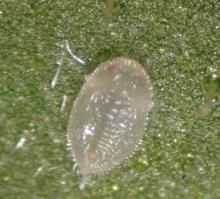Order Hemiptera: Family Aleyrodidae
Pest description and damage Whiteflies are tiny (less than 0.05 inch long), pure white, moth-like sucking insects that feed and lay eggs on the undersides of leaves. The nymphs appear as translucent yellow flattened elliptical discs and are mobile. As the nymphs reach the later instars, they become immobile and appear as thickened elliptical raised discs. Male and female whitefly adults emerge to mate and lay eggs. Tiny black eggs are laid in small circles, half circles or as scattered singles. Small circles that appear dusted with white powder may be noted. Damage varies by species but, in general, whiteflies suck plant sap from the phloem or plant cells. Leaves may turn yellow or dry and fall, or leaves are covered by honeydew colonized by sooty mold fungus. Some whiteflies can transmit viruses. Plant hosts include rhododendron and azalea, Indian plum, Ceanothus, fuchsia, and many other plants. The presence of whiteflies on the undersides of evergreen broadleaf plants in fall and winter may not be predictive of summer problems. High populations of whiteflies can severely damage fuchsias.
Biology and life cycle This insect has four instars: nearly invisible 1st instar, yellowish flat 2nd and 3rd instars and the 4th thickened instar before molting to the adult stage. In warm weather, populations can build quickly to cause considerable damage. Often, adult whiteflies overwinter on the host and emerge the following spring.
Pest monitoring Shake plants and search for flying adult whiteflies. If the adult whiteflies are present, check the undersides of leaves to verify young, feeding stages are present, or check for honeydew and sooty mold on the lower leaves or ground beneath the plant canopy. Determine whether the level of damage is worth control efforts.
Management-cultural control
Keep plants healthy and watered according to their needs. Whitefly populations increase with high nitrogen levels, so do not over-fertilize plants. Wash plants with a gentle stream of water directed to the underside of plants, or disturb foliage and vacuum adults. Prune back and encourage host plant regrowth. A combination of disturbing the foliage, vacuuming flying adults and using sticky yellow cards attractive to whiteflies provides some measure of control, but stay vigilant.
Management-biological control
The most noted biological control is Encarsia formosa, and there are several Encarsia species that can be purchased for release. Shipments include pupae encrusted on small cards that are clipped onto the host plant foliage. Make sure to put one card in a jar to observe hatch date and to determine if parasitoids are alive. Other predators and parasitoids are also active and together they often bring high populations back into check.
Management-chemical control
See Table 1 in:
Chemical Control of Landscape Pests
For more information
Flint, M.L. 2002. Whiteflies. University of California (https://ipm.ucanr.edu/PMG/PESTNOTES/pn7401.html#TABLE1)




